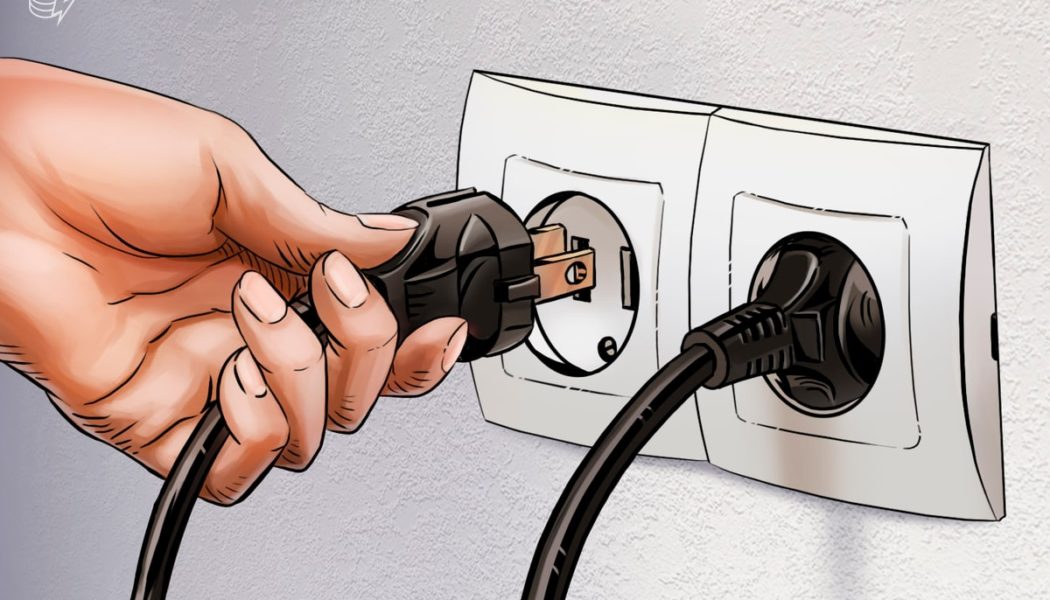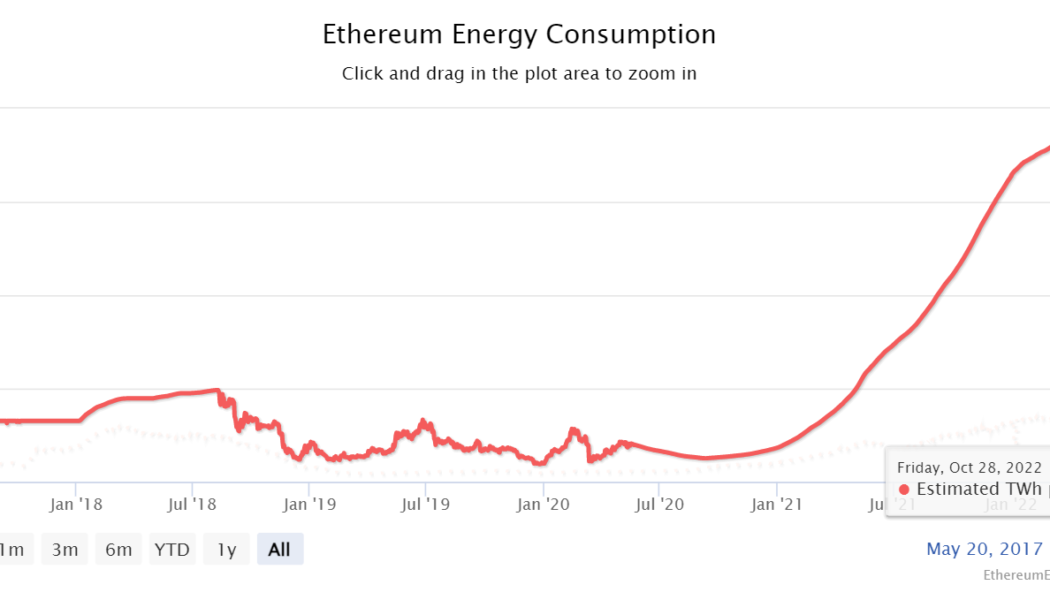Energy Consumption
1.5M houses could be powered by the energy Texas miners returned
During the winter storm in Texas in December 2022, Bitcoin (BTC) mining operators returned up to 1,500 megawatts of energy to the distressed local grid. It became possible due to the flexibility of mining operations and the ancillary services, provided by the state authorities. In his commentary to Satoshi Action Fund, Texas Blockchain Council president Lee Bratcher stated that miners returned up to 1,500 megawatts to the Texas grid. This amount of energy would be enough to heat “over 1.5 million small homes or keep 300 large hospitals fully operational,” according to the calculations from the Bitcoin advocacy group. While there’s no specification regarding the exact time period in which miners have accumulated such an amount of power, the global Bitcoin mining hashrate dropped by 30...
Why banking uses at least 56 times more energy than Bitcoin
The next time Bitcoin (BTC) comes under fire for energy consumption, remember this statistic: the banking industry uses at least 56 times more energy. That’s according to cryptographer and founder of Valuechain, Michel Khazzaka: “I’m not saying it uses less or the same, just know it uses 56 times more than Bitcoin.” The statistic, first shared by Michel Khazzaka in the summer, caused a stir in the Bitcoin and wider crypto community. He published his estimates in a Valuechain report, a company he founded to investigate the world of crypto payments. In an exclusive Cointelegraph Crypto Story interview, Khazzaka talks viewers through the extensive research that led to striking conclusions. In short, Bitcoin might not be as bad for the environment as the mainstream media lead peopl...
Quebec’s energy manager to seek government approval to stop powering crypto miners
Hydro-Québec, the firm managing electricity across the Canadian province of Quebec, plans to reallocate energy supplied to crypto mining firms. According to a Nov. 3 tweet from Canadian lawmaker Pierre Fitzgibbon, the government will request a decree from the energy board to release the company from its obligation to power crypto miners in the province. Hydro-Québec allocated 270 megawatts toward the mining firms, but electricity demand in Québec is expected to grow to a point that powering crypto will put pressure on the energy supplier. The report Hydro-Québec filed with the government’s energy board on Nov. 1 said temporarily reducing the power provided to mining firms could help prevent threats to the “reliability and security” of energy for Québec residents. The distributor repo...
The Merge brings down Ethereum’s network power consumption by over 99.9%
The Merge, which is considered one of the most significant blockchain upgrades on Ethereum (ETH) to date, brought down the network’s energy consumption by 99.9% immediately. On Sept. 15, the Ethereum blockchain migrated from proof-of-work (PoW) to a proof-of-stake (PoS) consensus mechanism in an effort to transition into a green blockchain. What followed was an immediate and steep drop in total energy consumption of the Ethereum network. The Ethereum Energy Consumption Index. Source: digiconomist.net Before the Merge upgrade, in 2022, the energy consumption of Ethereum ranged between 46.31 terawatt hour (TWh) per year to 93.98 TWh per year. The lowest energy consumption for Ethereum was recorded on Dec. 26, 2019, at 4.75 TWh per year. The estimated annual energy consumption in TWh/yr ...
Is post-Merge Ethereum PoS a threat to Bitcoin’s dominance?
While Ethereum (ETH) fans are enthusiastic about the successful Merge, Swan Bitcoin CEO Cory Klippsten believes the upgrade will lead Ethereum into a “slow slide to irrelevance and eventual death.” [embedded content] According to Klippsten, the Ethereum community picked the wrong moment for detaching the protocol from its reliance on energy. As many parts of the world are experiencing severe energy shortages, he believed the environmental narrative is taking the back seat. In an exclusive interview with Cointelegraph, Klippsten said “I think the world is just waking up to reality and Ethereum just went way off into Fantasyland at the exact wrong time.” “It is just really bad timing to roll out that narrative. It just looks stupid.” According to some predictions, institutional capital...
Merge is ‘a step in the right direction’ to address crypto’s energy usage — Rostin Behnam
Rostin Behnam, chair of the United States Commodity Futures Trading Commission, or CFTC, said the Ethereum blockchain’s transition to proof-of-stake may help reduce crypto’s energy usage, but hinted legislation would likely still be needed to address the problem. Speaking at a Thursday hearing before the Senate Agriculture Committee, Behnam addressed a question from Minnesota Senator Amy Klobuchar, who brought up the environmental impact of the “significant energy” required of mining cryptocurrencies. Without mentioning the Merge by name, the CFTC chair said the crypto bill currently being considered by lawmakers would require a report on energy usage that could lead to future policy discussion and “incentives to move away from carbon-intensive energy sources.” “We’ve all heard the statist...
‘There’s a lot less land to go around’ — why White Rock established off-the-grid mining in Texas
Amid many cryptocurrency mining firms in Texas scaling down operations to reduce the load on the power grid, at least one company set up miners not quite as affected by the state’s energy requirements during extreme heat. In June, White Rock Management expanded its crypto mining operations to Texas — its first in the United States — but reported its facility in the Brazos Valley region would mine Bitcoin (BTC) using “environmentally responsible” methods. While the firm’s mining operations in Sweden used hydroelectric power, White Rock CEO Andy Long told Cointelegraph that its Texas facility was “off grid”, powered only by natural gas that would otherwise be burned. “The U.S. is where the action is in terms of markets, so we plan to be in at least another couple of states as well as Texas w...
Core Scientific increased Bitcoin production by 10% in July amid Texas power cuts
Crypto mining firm Core Scientific reported its operations produced 1,221 Bitcoin (BTC) in July even as the company powered down several times in response to demand on the Texas power grid. In a Friday announcement, Core Scientific said its month-over-month Bitcoin production had increased from 1,106 in June to 1,221 in July — roughly 10.4%. The firm reported curtailing operations “due to extreme temperatures at multiple data centers,” but also increased the number of its self-mining servers and hashrate by 6%, to 109,000 and 10.9 exahashes per second (EH/s), respectively. JULY 2022 HIGHLIGHTS:-1,221 #Bitcoin self-mined-10.9 EH/s self-mined-+190,000 ASIC servers in operation-8.4 EH/s colocation (hosting)-Deployed first BITMAIN ANTMINER S19 XPs in the United Stateshttps://t.co/Qt2...
Crypto firms failed to deliver ‘promised benefits’ from lawmaker-backed incentives, says nonprofit
The Tech Transparency Project, or TTP, a research initiative of the United States-based nonprofit watchdog group Campaign for Accountability, has released a report claiming crypto firms “provided little in return” for state governments offering financial incentives. In a report released Thursday, the TTP said that many crypto firms based in certain U.S. states have “reaped special benefits” for setting up operations while not always delivering jobs, economic growth or tax benefits for residents. According to the group, crypto lobbyists worked on behalf of firms to gain tax breaks and discounted energy prices while state governments have “faced budget shortfalls, surging energy consumption and serious environmental damage.” A new TTP report outlines favorable laws and tax breaks given...
Will the Bitcoin mining industry collapse? Analysts explain why crisis is really opportunity
Bitcoin mining involves a delicate balance between multiple moving parts. Miners already have to face capital and operational costs, unexpected repairs, product shipping delays and unexpected regulation that can vary from country to country — and in the case of the United States, from state to state. On top of that, they also had to contend with Bitcoin’s precipitous drop from $69,000 to $17,600. Despite BTC price being 65% down from its all-time high, the general consensus among miners is to keep calm and carry on by just stacking sats, but that doesn’t mean the market has reached a bottom just yet. In an exclusive Bitcoin miners panel hosted by Cointelegraph, Luxor CEO Nick Hansen said, “There’s going to definitely be a capital crunch in publicly listed companies or at least ...
How blockchain can address Austria’s energy crisis
Climate change has become one of the biggest global challenges for humanity. At the same time, the dependence on hydrocarbon energy sources such as coal, oil and natural gas is still strong. Supply lines around these energy sources are further vulnerable to geopolitical tensions. Due to the current sanctions against Russia, experts now expect rising electricity prices and negative effects on the energy market in Europe. The Austrian government understands the urgent need for the energy transition and has set the ambitious goal of being climate neutral by 2040. Alternative solutions to fossil energy have been slow to emerge and, for the most part, are not yet efficient enough on a large scale. But there are promising approaches — especially in the form of decentralized renewable energies or...
The Merge is Ethereum’s chance to take over Bitcoin, researcher says
Ethereum researcher, Vivek Raman, is convinced that Ethereum’s (ETH) upcoming transition to a proof-of-stake system will enable it to take over Bitcoin’s (BTC) position as the most prominent cryptocurrency. “Ethereum does have, just from an economic perspective and because of the effect of the supply shock, a chance to flip Bitcoin,” said Raman in an exclusive interview with Cointelegraph. [embedded content] The Merge, a long-awaited upgrade that will complete Ethereum’s transition from a proof-of-work to a proof-of-stake system, is set to take place in September. In addition, The Merge will transform Ethereum’s monetary policy, making the network more environmentally sustainable and reducing ETH’s total supply by 90%. “After The Merge, Ether...
- 1
- 2























